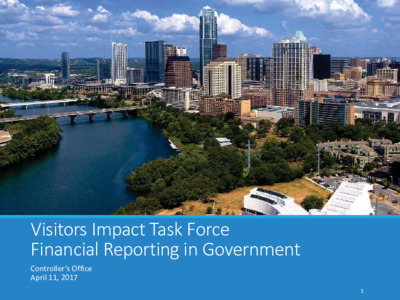Visitors Impact Task Force Financial Reporting in Government Presentation, April 11, 2017 Meeting — original pdf
Backup

Visitors Impact Task ForceFinancial Reporting in GovernmentController’s OfficeApril 11, 20171 Sources of Financial InformationThere are several sources for financial information about City operations including:oComprehensive Annual Financial Report (CAFR): oReport prepared by the Controller’s Office annuallyoBased on generally accepted accounting principles (GAAP)oMuch of the report is audited by the City’s external auditoroApproved Budget: oReport prepared by the Budget Office for Operating and Capital budgetingoBased on budgeting principles focused on current available resources and spending (this is consistent with other municipalities and governments across the country)oOnce CAFR is complete, Controller’s Office provides prior year actual beginning balance, available funds, requirements, and ending balance amountsoProposed budget amounts are initially provided by departments and modified as needed by managementoCapital improvement plan:oReport prepared by the Budget OfficeoFocuses on longer term capital needs of the CityoProposed budget amounts are initially provided by departments and modified as needed by managementoOther financial reports not listed separately2 Report FrameworkKey items included in each report:oComprehensive Annual Financial Report (CAFR):oStatement of Net Position (Balance Sheet)oStatement of Revenues, Expenditures and Changes in Net Position (Income Statement)oStatement of Cash FlowsoPlus footnotes and other disclosuresoApproved Budget: oDepartment Budgets include an overview, mission and goals, message from the director, budget highlights, significant changes, budget details by activity, and other summary informationoFund Summaries (income statement-like budget-basis report)oPlus other information about the City’s operations oCapital improvement plan:oSpending plan (when will the City need funds to pay for improvements)oAppropriation summaries reflect current funding levels and planned future requirementsoDepartment narratives explain their program and highlight major planned projectsNote: Although these reports may be prepared for the same period of time –a fiscal year –there are differences in the basis of reporting for each. 3 CAFRoStatement of Revenue, Expenses and Changes in Net PositionoFull accrual basis accountingoIncludes depreciation (use of capital assets over their useful life)oAcquisition of capital does not impact income statementoDebt payments -only reflect interest expense (paid and due as of statement date)oOne column for enterprise activity (i.e. Convention Center)oRecognition of current period costs for long term liabilities associated with employee benefits -net pension liabilities and other postemployment benefits (medical, dental, life, etc.)4https://assets.austintexas.gov/financeonline/downloads/cafr/cafr2016.pdf BudgetoBudget: Budget is “income statement” focusedoCloser to cash basis accounting, but includes some accruals like payroll, receivables, etcoExcludes depreciationoIncludes acquisition of capital (full purchase price is an expenditure of the period)oDebt payments include both principal and interest dueoMultiple fund summaries (10+) that make up one column on CAFR including: Convention Center (CC) HOT Revenue Bond Redemption, CC Marketing and Promotion, CC Operating, Palmer Events Center (PEC) Garage, PEC Operating, PEC Revenue, CC Repair and Replacement, CC Tax, CC Town Lake Park Venue Project Bond Redemption, CC Venue Project, plus CC & PEC capital projects funds and debt service reserve funds.5https://assets.austintexas.gov/budget/16-17/downloads/Approved_Volume_1_FINAL.pdf